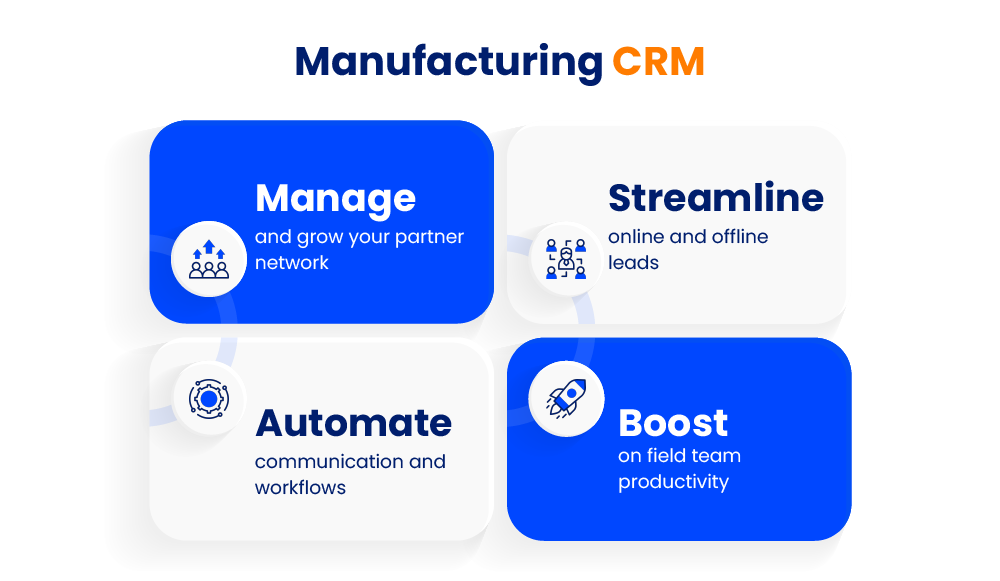Manufacturing is a big and complex industry with many processes, technologies and workflows. Each area has its own challenges and metrics of success. From production efficiency to supply chain management, this world is full of Key Performance Indicators – manufacturing KPIs – that help organisations navigate the landscape. However, one area that often gets overlooked is the sales function, which is key to growth and profitability.
To drive sales in manufacturing, you need to align manufacturing KPIs to business objectives. This ensures sales teams are not just closing deals but also understand the impact of their efforts on production and inventory.
By tracking these metrics you can spot trends, optimize your sales processes, and improve your market position.
In this blog, we will examine manufacturing KPIs that help boost sales. While production metrics give insight into operational efficiency, understanding the sales side is just as important!
Why Are These Manufacturing KPIs Important?
KPIs, whether for sales or any other function, also work as a communication tool across teams. They help create a culture of accountability and continuous improvement. When everyone measures the same things, finding inefficiencies, celebrating successes, and setting future goals is easier.
Thanks to the performance of key sectors, including automotive, engineering, chemicals, pharmaceuticals, and consumer durables, manufacturing is starting to stand out as a crucial pillar of India’s economic growth. Before the COVID-19 pandemic, the country’s manufacturing sector accounted for 16–17% of the national GDP, and it is expected to increase at one of the quickest rates.
Not just about great products
In manufacturing, it’s not just about making great products; it’s about truly understanding your customers and turning those insights into business outcomes. It’s also about building and managing great sales teams that deliver.
The sales function in manufacturing has its own challenges, from complex product offerings to long sales cycles. So, having the right KPIs in place helps teams better measure their performance and adapt to the changing market.
Knowing and tracking KPIs can let sales managers make data driven decisions to refine sales funnels. They also allow managers to measure the success of their sales processes and hit revenue targets.
Let’s see some important manufacturing KPIs that can be used to streamline processes and increase sales.
10 Key Manufacturing KPIs to Boost Sales
In today’s market, manufacturers need data to win. Knowing and tracking manufacturing KPIs can help sales managers make data-driven decisions and refine sales funnels. They also allow measuring sales processes so that revenue targets can be better hit.
These manufacturing KPIs cater to the sales teams of the manufacturers (trade and institutional sales) and sales teams of the distributors (retail sales).
Let’s dive in!
Order management KPIs
Order management is key for manufacturers. Here are the KPIs to track:
1. Order fulfillment rate
This is the percentage of orders fulfilled on time and in full. A high fulfillment rate means efficiency and customer happiness.

Where:
- Number of Orders Fulfilled on Time: Number of orders delivered to customers by the due date or promised date, and meeting all specifications.
- Total Number of Orders: Total number of orders for the same period.
For example:
If a company got 1000 orders in a month and delivered 900 of them on time and in full, the calculation would be:
Order Fulfillment Rate = 900/1000 × 100 = 90%
If manual processes stress you out, take it easy with LeadSquared: it allows you to automate order tracking and notifications, so customers are always updated on their order status.
“Turnaround time is the heartbeat of operational efficiency… Reducing TAT means quicker launches, faster response to market changes, and a more agile team. Measuring and optimizing TAT ensures that we’re not just working hard, but working smart.”
– Ishita Paul, Marketing Operations Executive, LeadSquared
2. Order cycle time
The time from order to delivery is critical. Shorten this turnaround time (TAT) and you’ll improve customer experience and in turn customer retention. You’ll also reduce inventory holding costs.

Where:
- Order Placement Date: The date when the customer places the order.
- Order Delivery Date: The date when the order is delivered to the customer.
Data management KPIs
Good data management can simplify operations and give you insights. Here are KPIs you can track for it:
3. Lead conversion rate
This is the percentage of leads that turn to customers. LeadSquared’s automated lead nurturing improves conversion rates by following up at the right time and personalizing communication.

Where:
- Number of Converted Leads: The quantity of leads that either fulfilled the required action or turned into paying clients.
- Total Number of Leads: The total number of leads generated throughout a specific time frame.
4. Sales forecast accuracy
How close are your sales forecasts to actual sales?
It should come as no surprise that sales, a department that relies heavily on numbers, gains from appropriate analytics. We suggest using LeadSquared’s advanced analytics to analyze historical data, track trends, see patterns that impact your sales, and dig deeper into your sales performance.
Also, having a clear view of how your forecasts match up to actual sales will help you make strategic adjustments in real-time. This proactive approach minimizes risks and helps you better respond to market changes. Ultimately, investing in analytics is a step towards optimizing your sales strategy and growing your business.
Influencer mapping KPIs
Understanding influencers and decision-makers in the buying process is key, especially in institutional sales. Track these KPIs:
5. Decision-maker engagement rate
How often do key decision-makers engage with your sales team? Measure this to see how well your outreach is working.

Where:
- Number of Engaged Decision-makers: The number of decision-makers who have interacted with your brand (ex: attended meetings, responded to emails, engaged on social media).
- Total Number of Targeted Decision-makers: The number of decision-makers your outreach efforts were aimed at.
For Example:
If you targeted 50 decision-makers and 15 engaged with your outreach, the calculation would be:
Decision Maker Engagement Rate = (15 / 50) × 100 = 30%
LeadSquared’s Manufacturing CRM lets you track interactions with influencers so you can tailor your approach as required and get better at the game!
6. Influencer conversion rate
This KPI is the percentage of influencers who facilitate the process from lead to sales. By mapping relationships, you can see which influencers are yielding the best results and focus your marketing on them.

Where:
- Number of Conversions from Influencer Campaign: Total number of leads that converted as a direct result of the influencer’s campaign or promotion.
- Total Engagements from Influencer Campaign: Total interactions (clicks, shares, comments, etc.) from the influencer’s posts or promotions.
You can further use a CRM to map dealers, distributors and influencers so any quality issues are addressed and managed quickly.

Sales revenue and growth metrics
Revenue is the end goal for any sales team, yes? So, these KPIs are extremely important:
7. Total sales revenue
This is the total revenue for a given period. Tracking this metric helps manufacturers see overall financial health and set realistic targets.

Where:
- Number of Units Sold: Total number of products sold.
- Selling Price Per Unit: Unit price of each unit.
Hitting those targets requires a dedicated and motivated sales team. How do you ensure that?
Consider using Ace, from LeadSquared. Ace is a powerful Sales Performance Management suite aimed at improving your most important business metrics. It gives sales leaders the ability to set specific goals for their teams, and provides them with the analytical and psychological tools necessary to guarantee success.
It offers flexible incentive creation and customized alignment options. Examine each person’s performance, focus on their impact, and comprehend the team dynamics!
8. Sales growth rate
This is the percentage increase in sales revenue from a previous period.

Where:
- Sales in Current Period: Total sales for this period (ex: month, quarter, year).
- Sales in Previous Period: Total sales for the prior comparable period.
For example,
If a company had $200,000 in sales last year and $250,000 this year, the calculation would be:
Sales Growth = (250,000 – 200,000) × 100 = 25%
You can use platforms such as LeadSquared to access these kinds of trends, see what’s working and what’s not, and adjust accordingly.

9. Sales per representative
Individual performance is key to optimizing sales teams. This metric measures total sales by each sales representative.

Where:
- Total Sales Revenue: The total income generated from sales during the specified period.
- Number of Sales Representatives: Total sales reps for that period.
LeadSquared will show you your top performers and where more training is needed. With the CRM, you can easily create and send automated beat plans, record meetings, monitor your salespeople’s productivity, and do much more!
Oh, and you can even track your field sales agents in the palm of your hand – through the seamless Mobile CRM.
Customer acquisition
Knowing the cost of getting new customers is key to profitability:
10. Customer Acquisition Cost (CAC)

This is the total cost of a new customer, including marketing and sales spending.

Where:
- Total Sales and Marketing Expenses: All costs related to marketing campaigns, advertising, salaries of sales and marketing people, tools and technology, and other expenses over a period.
- Number of New Customers Acquired: The number of new customers in that same period.
For example,
If a manufacturing company spends $100,000 on sales and marketing and gets 200 new customers, the calculation would be:
CAC= $100,000 / 200 = $500
Keep track of CAC to see how your sales and marketing teams are performing.
Wrapping Up

Focusing on the above KPIs can provide valuable insights to inform strategy and improve performance.
Manufacturing excellence is a journey of data-informed decisions. Integrating a robust platform like LeadSquared to these processes can help manufacturers and distributors to succeed in a competitive market. And help sales teams thrive!
Consider using tools like LeadSquared’s Manufacturing CRM. Use these KPIs to get and stay ahead.
Just like some of the world’s top manufacturers and their distributors and partners – Greenlam Industries, NCL Group, Greenply Plywood, Symphony, and more!
Ready to rev up your revenue? Don’t wait! Book a demo today to see LeadSquared in action.







